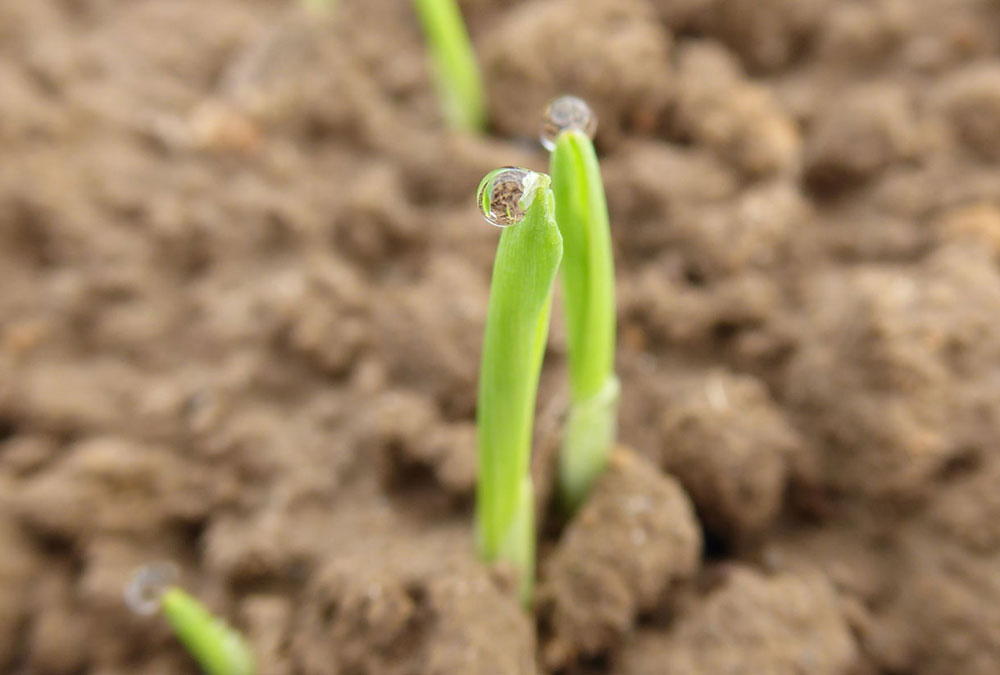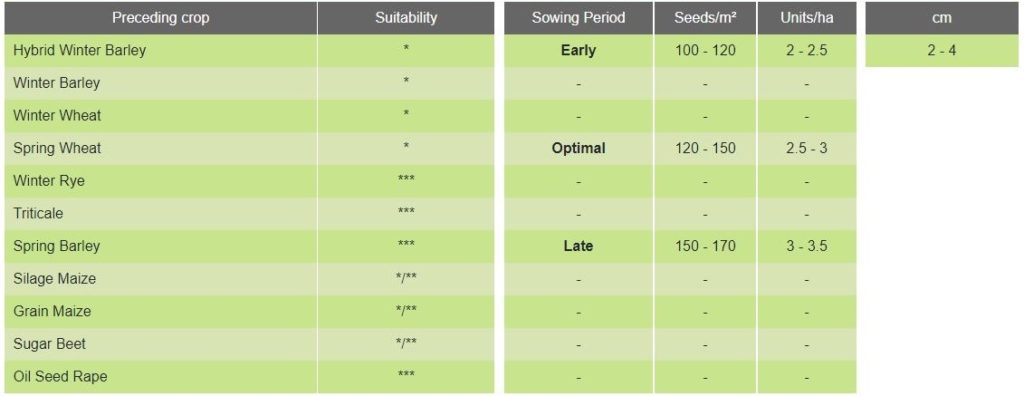Growing Technology
As being an early harvested crop winter hybrid barley offers many possibilities in terms of crop rotation. It is very suitable as a preceding crop to winter oilseed rape, sugar beet, potatoes, oats, maize as well as sunflowers. Winter barley as a preceding crop to other cereals – only moderately suitable due to problems with volunteers as well as disease spread.
Site choice
Hybrid barley is suitable for soils ranging from light to clay loams with a water deficit.
Sowing depth
In that respect hybrid barley is not any different than conventional varieties. A finely textured seedbed and a sowing depth of 2 to 4 cm is recommendable ensuring optimal crop emergence.
Seed rate and sowing date: Two related factors
Due to its heterosis hybrid barley has a considerable compensation ability. A reduced seed rate can be compensated by vigorous tillering so that at the end the crop achieves the necessary number of ears without any problems. In good sowing conditions seed rates of 70 % of the conventional varieties are recommended. By reducing the seed rate the focus shifts more to the individual plant development.

The sowing date of hybrid barley is quiet variable so that even late sowing is possible if the seed rate is adjusted.
Insecticides
At present hybrid barley breeders work intensively on varieties which are resistant to BYDV (barley yellow dwarf virus). Currently available hybrid barley varieties do not have any resistance to BYDV. The virus is transmitted by aphids and causes golden yellow leaf discoloration as well as stunting. To protect the crop from the virus the crop should be monitored for aphids shortly after sowing. If aphid infestations exceed the threshold an insecticide treatment should be carried out.
Like any other crop, hybrid barley has a certain nitrogen requirement. This nitrogen requirement depends on soil quality, water availability as well as the preceding crop. Additionally, the site’s yield potential as well as the soil nutrient supply have to be taken into account.
Autumn:
Because of the reduced seed rate a good establishment of hybrid barley should be ensured before the winter. Depending on the site and preceding crop an optimal numbers of tillers can be enhanced by applying organic or mineral fertiliser in the autumn.
Spring:
The first fertiliser application should be applied in good time at the start of the growing season (BBCH 25/27). The second application should follow at BBCH 31/32. The third application is already carried out at BBCH 39 to secure the thousand grain weight as well as other quality parameters.
Winter barley requires on average
20 to 35 kg/ha sulphur depending on the site. Sulphur improves the plants’ nitrogen use efficiency and therefore increases the yield.
It is recommendable to treat the crop with plant growth regulators in the spring as barley has a very vigorous growth. The decision if one or two applications are necessary should depend on the crop’s development and other environmental factors. If a high yield is expected the first treatment should already be carried out at BBCH 30/31.
Fungicides
Hybrid barley varieties have a high resistance to the winter barley diseases Ramularia leaf spot caused by the pathogen Ramularia collo-cygni and rhynchosporium caused by the pathogen Rhynchosporium commune. However, depending on the infection pressure 1 to 2 applications are necessary. The first treatment can be combined with the plant growth regulator application. The second one should be carried out at a later stage (from BBCH 37).
Hybrid Barley Agronomy Guide
Cultivation suitability depending on preceding crop
Sowing period and seed rate
Sowing depth
Preceding crop
Suitability
Sowing Period
Seeds/m²
Units/ha
cm
Hybrid Winter Barley
*
Early
100 - 120
2 - 2.5
2 - 4
Winter Barley
*
-
-
-
Winter Wheat
*
-
-
-
Spring Wheat
*
Optimal
120 - 150
2.5 - 3
Winter Rye
***
-
-
-
Triticale
***
-
-
-
Spring Barley
***
Late
150 - 170
3 - 3.5
Silage Maize
*/**
-
-
-
Grain Maize
*/**
-
-
-
Sugar Beet
*/**
-
-
-
Oil Seed Rape
***
-
-
-

***recommendable
**possible
*not recommendable
Important note: General growing recommendation. Please adjust according to the actual field situation.
Hybrid Barley Agronomy Guide
Nitrogen fertilisation

Stage-Affects-Goal
Option 1
Alternative splitting
Start of vegetation Affects: Number of grains per ear, number of ear-bearing stalks Goal: To generate or maintain sufficiently strong shoots <
BBCH 25/27: N-P-K+S 30-50 % of total N amount 50 % of total S amount
BBCH 25/27: N-P-K+S 30-50 % of total N amount 30 % of total S amount <
Shooting Affects: Number of spiked stalks, number of seeds per ear Goal: Promotion of the first and second order shoots, protection of the number of grains per ear
BBCH 29/32 N-P-K+S 20-40 % of total N amount 50 % of total S amount
BBCH 29-32 N (stabilized form) -P-K + S 50-70 % of total N amount + 70 % of total S amount
Earing Affects: Thousand grain mass and quality Goal: high TKW and / or high protein levels .
BBCH 51/59 for HYWW: latest application stage BBCH 39 N only: 30 % of total N amount
no <. <.
Plant growth regulator

Necessity
2nd application if required
EC 30-32: Trinexapacethyl 0,4–0,57 l/ha or Chlormequat 0,55 l/ha + Ethefon 0,75 l/ha
BBCH 37–39: 0,4l/ha Ethefon
Fungicide treatments
Depending on disease pressure
Important note: General growing recommendation. Please adjust according to the actual field situation.
